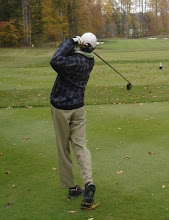I recently had the opportunity to play a course in the Philadelphia, PA area called Walnut Lane Golf Club.
Walnut Lane G.C. is part of a large park in the greater Philadelphia area and it was designed by Alexander Findlay in 1940.
The total yardage of the course from the way back is 4509 and you can imagine there are no par 5s. The front and back nines are a blend of 4 par 4s and 5 par 3s. Now, at 4509 and 5- par 3s there are some pretty challenging par 3s. In fact there are a few par 3s that are over 200 yards coupled with postage stamp sized greens! The rest of the par 3s had you dealing with elevation changes, strategic bunkering and trees hugging the hole from tee to green.
The par 4s we're all some kind of dogleg with trees lining each one. There were few places to go except the fairway so a controlled shot was imperative.
I happen to LOVE golf like this. If you can hit a good iron shot, you can do pretty well. The short game is at a premium and good putting is always needed. Length while important on some of the par 3s gives way to the need for accuracy. When a hole is literally cut out of the woods, and has some elevation changes but not too drastic to keep me from seeing the shot as it unfolds, it's so much easier to focus on the exact type of shot I want to hit. And when I hit it, I get the reward of being able to watch its entirety.
All in all a very pleasant round of golf. I walked 18 and didn't feel like I was just put through a military training camp. I'd recommend this course to anyone visiting or living in the Philly area. Just a fun bit of golf and only 2 1/2 hours to finish 18!
Walnut Lane G.C. is part of a large park in the greater Philadelphia area and it was designed by Alexander Findlay in 1940.
The total yardage of the course from the way back is 4509 and you can imagine there are no par 5s. The front and back nines are a blend of 4 par 4s and 5 par 3s. Now, at 4509 and 5- par 3s there are some pretty challenging par 3s. In fact there are a few par 3s that are over 200 yards coupled with postage stamp sized greens! The rest of the par 3s had you dealing with elevation changes, strategic bunkering and trees hugging the hole from tee to green.
The par 4s we're all some kind of dogleg with trees lining each one. There were few places to go except the fairway so a controlled shot was imperative.
I happen to LOVE golf like this. If you can hit a good iron shot, you can do pretty well. The short game is at a premium and good putting is always needed. Length while important on some of the par 3s gives way to the need for accuracy. When a hole is literally cut out of the woods, and has some elevation changes but not too drastic to keep me from seeing the shot as it unfolds, it's so much easier to focus on the exact type of shot I want to hit. And when I hit it, I get the reward of being able to watch its entirety.
All in all a very pleasant round of golf. I walked 18 and didn't feel like I was just put through a military training camp. I'd recommend this course to anyone visiting or living in the Philly area. Just a fun bit of golf and only 2 1/2 hours to finish 18!

